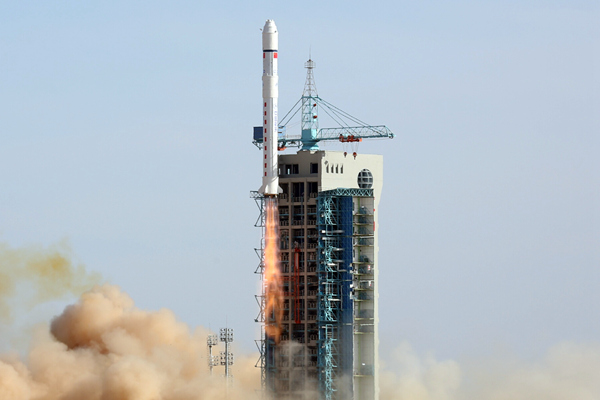
A Long March 2D rocket carrying several satellites is launched on Feb 2.[Photo/China Daily]
China’s first individually funded satellite was launched on Feb 2 and will operate in space for one year to take and transmit pictures and videos of the universe, according to parties involved in the program.
The FMN 1 is a panoramic-camera CubeSat, a type of miniaturized satellite made up of multiple cubic units, and will be used to help members of the public observe outer space, according to a statement from China Great Wall Industry Corp, which provided the launch service.
The satellite was lifted atop a Long March 2D carrier rocket at the Jiuquan Satellite Launch Center in northwestern China, along with the much larger ZH 1-the nation’s first seismo-electromagnetic satellite, which can help scientists better study earthquakes-as well as five other small satellites like the FMN 1.
The satellite program was funded solely by real estate tycoon Feng Lun, chairman of Beijing-based Vantone Holdings, who is also author of several business-theme books, according to Hu Zhenyu, CEO of LinkSpace Aerospace Technology, a space industry startup in Shenzhen, Guangdong province, that was commissioned by Feng to develop and build the satellite.
All of the Chinese spacecraft previously launched were funded by the government, State-owned space contractors or private companies rather than an individual.
Hu said the 3-kilogram FMN 1 has a high-resolution camera with two panoramic lenses, capable of capturing images and videos of Earth and space alike. He said the satellite’s development started in March last year and finished in August, adding that his company will make other satellites for Feng. He refused to elaborate, citing business confidentiality.
Feng could not be reached for comment on Feb 2. He was quoted in earlier reports by Chinese media as saying that he hoped the satellite could enable the public to get close contact with space and also give him a new platform for mass communication. He also said the satellite would fly over China three times a day and will be able to transmit data back to the ground at those times.
The property magnate did not reveal the cost of the program, according to the reports.
Fu Zhiheng, vice-president of China Great Wall Industry, said the launch contract was signed between Great Wall and LinkSpace and that the cost for the lift service “wasn’t very high”.
An industry insider with knowledge of the program who wished not to be identified said the overall cost of the satellite’s development and launch would be less than 10 million yuan ($1.6 million).
He said that if a businessperson wishes to invest in a satellite program, the small camera or video satellite is the best option because, compared with other satellite models, it is more easily and cheaply designed and made and can attract more users from the public, which means it offers better profitability.
The insider also said startups like LinkSpace will be major developers of such satellites, since State-owned space institutes are too busy on government-assigned contracts to receive orders from private companies or individuals.
Pang Zhihao, a researcher at the China Academy of Space Technology, said it is not overly complex for an individual to sponsor or fund a spacecraft because there are specific, clear policies and reliable contractors in the market, although whether the investment will pay off depends on market demand.
